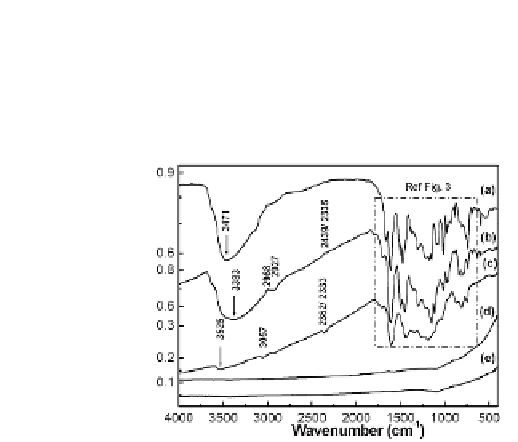Biomedical Engineering Reference
In-Depth Information
for CA900 are present, which result from C−C vibrations of aromatic
rings. However, most peaks in the fingerprint region disappear for
samples that are heated to higher temperatures (>500
C).
Figure 3.2
FTIR of CAs dried and heated at different temperatures for
3 h under flowing N
(1.5 L/min): (a) as-prepared at 75°C,
(b) CA250, (c) CA500, (d) CA750, and (e) CA900.
2
The disappearance of these peaks has been attributed to burn-
of of residual organic solvent and volatile products from chemical
reactions and decompositions which is also evidenced by TGA/DTA
results. In general, the functional group region of an FTIR spectrum
(4000-1400 cm
-1
) is where most of the functional groups show
absorption bands; the fingerprint region can clearly characterize
the bond vibrations with stretching and bending modes, as shown in
Fig. 3.3.
IR absorption bands at 1664, 1606, 1503, and 1469 cm
-1
are
associated with aromatic and furan ring stretching vibrations, as
shown in Fig. 3.3a, which are assigned by O=C aromatic ring, O-CH
,
2
and C-CH
-C. These peaks begin to overlap with temperatures above
500°C, as shown in Fig. 3.3c. The peak intensities become very weak
for both CA750 at 1576 cm
2
-1
-1
.
IR absorption bands at 1664, 1606, 1503, and 1469 cm
and CA900 at 1567 cm
-1
are
associated with aromatic and furan ring stretching vibrations, as
shown in Fig. 3.3a, which are assigned by O=C aromatic ring, O-CH
,
2
and C-CH
-C. These peaks begin to overlap with temperatures above
500°C, as shown in Fig. 3.3c. The peak intensities become very weak
for both CA750 at 1576 cm
2
-1
-1
and CA900 at 1567 cm
.


